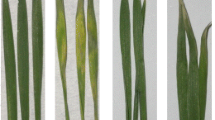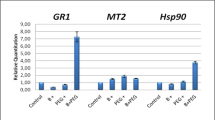Abstract
Despite the demonstration that proline accumulation and gene expression of Δ1-pyrroline-5-carboxylate synthase (p5cS) increased under osmotic stress, the impact of excess boron on proline metabolism is not well known. Therefore, we investigated the effect of different boron concentrations (10, 50, 70, 140 and 200 ppm) on seedlings root growth, lipid peroxidation rate, antioxidant enzyme activity (glutathione reductase (GR), ascorbate peroxidase (APX), catalase (CAT)), proline accumulation and transcription level of p5cS gene in Triticum aestivum L. AK-702. It was observed that seed germination and root growth in T. aestivum decreased depending on the concentration of boron. Our results indicated that boron toxicity induced lipid peroxidation and decreased GR activity under a high concentration of boron. However, the APX activity did not significantly change under high concentrations of boron (70, 140 and 200 ppm), while it increased under the lower levels of boron (10 and 50 ppm). In addition, excess boron enhanced CAT activity in the 200 ppm boron treated groups. Proline accumulation increased 2.25 and 1.45 fold in the 140 and 200 ppm boron applications. In addition, analyses of the mRNA transcription level using the semi-quantitative RTPCR results showed that excess boron increased the p5cS mRNA transcript levels and showed a positive correlation of these levels with proline accumulation in T. aestivum roots.
Similar content being viewed by others
Abbreviations
- APX:
-
ascorbate peroxidase
- CAT:
-
catalase
- GR:
-
glutathione reductase
- MDA:
-
malondialdehyde
- POX:
-
peroxidase
- p5cS-Δ1 :
-
pyrroline-5-carboxylate synthase
- SOD:
-
superoxide dismutase
- TBARS:
-
thiobarbituric acid reactive substances
References
Zohary, D., Hopf, M., and Weiss, E., Domestication of Plants in the Old World, Oxford: Clarendon, 2012.
Erekul, O., Kautz, T., Ellmer, F., and Turgu, I., Yield and bread-making quality of different wheat (Triticum aestivum L.) genotypes grown in Western Turkey, Arch. Agron. Soil Sci., 2009, vol. 55, pp. 169–182.
Eraslan, F., Inal, A., Savasturk, O., and Gunes, A., Changes in antioxidative system and membrane damage of lettuce in response to salinity and boron toxicity, Sci. Hort., 2007, vol. 114, pp. 5–10.
Karabal, E., Yücel, M., and Öktem, H.A., Antioxidant responses of tolerant and sensitive barley cultivars to boron toxicity, Plant Sci., 2003, vol. 164, pp. 925–933.
Reid, R., Identification of boron transporter genes likely to be responsible for tolerance to boron toxicity in wheat and barley, Plant Cell Physiol., 2007, vol. 48, pp. 1673–1678.
Foyer, C.H. and Noctor, G., Redox sensing and signaling associated with reactive oxygen in chloroplast, peroxisomes and mitochondria, Physiol. Plant., 2003, vol. 119, pp. 355–364.
Mittler, R., Oxidative stress, antioxidants and stress tolerance, Trends Plant Sci., 2002, vol. 7, pp. 405–410.
Ruiz, J.M., Rivero, R.M., and Romero, L., Preliminary studies on the involment of biosynthesis of cysteine and glutathione in the resistance to boron toxicity in sunflower plants, Plant Sci., 2003, vol. 165, pp. 811–817.
Cervilla, L.M., Blasco, B., Rios, J.J., Romero, L., and Ruiz, J.M., Oxidative stress and antioxidants in tomato (Solanum lycopersicum) plants subjected to boron toxicity, Ann. Bot., 2007, vol. 100, pp. 747–756.
Gunes, A., Soylemezoglu, G., Inal, A., Bagci, E.G., Coban, S., and Sahin, O., Antioxidant and stomatal responses of grapevine (Vitis vinifera L.) to boron toxicity, Sci. Hort., 2006, vol. 110, pp. 279–284.
Kishor, B.P.K., Hong, Z., Miao, G.H., Hu, C.A.A., and Verma, D.P.S., Overexpression of Δ1-pyrroline-5-carboxylate synthetase increases proline production and confers osmotolerance in transgenic plants, Plant Physiol., 1995, vol. 108, pp. 1387–1394.
Mehta, S.K. and Gaur, J.P., Heavy-metal-induced proline accumulation and its role in ameliorating metal toxicity in Chlorella vulgaris, New Phytol., 1999, vol. 143, pp. 253–259.
Yoshiba, Y., Kiyosue, T., Katagiri, T., Ueda, H., Mizoguchi, T., Yamaguchi-Shinozaki, K., Wada, K., Harada, Y., and Shinozaki, K., Correlation between the induction of a gene for Δ1-pyrroline-5-carboxylate synthetase and the accumulation of proline in Arabidopsis thaliana under osmotic stress, Plant J., 1995, vol. 7, pp. 751–760.
Delauney, A.J. and Verma, D.P.S., Proline biosynthesis and osmoregulation in plants, Plant J., 1993, vol. 4, pp. 215–223.
Hu, C.C.A., Delauney, A.J., and Verma, D.P.S. A bifunctional enzyme (Δ1-pyrroline-5-carboxylate synthetase) catalyzes the first two steps in proline biosynthesis in plants, Proc. Natl. Acad. Sci. USA, 1992, vol. 89, pp. 9354–9358.
Hong, Z., Lakkineni, K., Zhang, Z., and Verma, D.P.S., Removal of feedback inhibition (Δ1-pyrroline-5-carboxylate synthetase) results in increased proline accumulation and protection of plants from osmotic stress, Plant Physiol., 2000, vol. 122, pp. 1129–1136.
Heath, R.L. and Packer, L., Photoperoxidation in isolated chloroplast: 1. Kinetics and stoichiometry of fatty acid peroxidation, Arch. Biochem. Biophys., 1968, vol. 125, pp. 189–198.
Bates, L.S., Waldren, R.P., and Tear, I.D., Rapid determination of free proline for water-stress studies, Plant Soil, 1973, vol. 39, pp. 205–207.
Bradford, M.M., A rapid and sensitive method for the quantitation of microgram quantities of protein utilizing the principle of the protein–dye binding, Anal. Biochem., 1976, vol. 72, pp. 248–254.
Bergmeyer, N., Methoden der enzymatischen Analyse, Berlin: Akademie Verlag, 1970, vol. 1, pp. 636–664.
Nakano, Y. and Asada, K., Hydrogen peroxide is scavenged by ascorbate specific peroxidase in spinach chloroplasts, Plant Cell Physiol., 1981, vol. 22, pp. 867–880.
Yɩlmaz, G. and Leblebici, S., Farklɩ konsantrasyonlardaki borik asidin bazɩ Carthamus tinctorius L. (Compositae) çesitlerinin tohum çimlenmesi üzerine etkileri, The 19th Ulusal Biyoloji Kongresi Özet Kitapçigɩ (Trabzon, Haziran 23–27, 2008), Trabzon: Karadeniz Teknik Üniv., 2008, p.385.
Turton, T.E., Dawes, I.W., and Grant, C.M., Saccharomyces cerevisiae exhibits a yAP-1 mediated adaptative response to malondialdehyde, J. Bacteriol., 1997, vol. 179, pp. 1096–1101.
Brown, P.H., Bellaloni, N., Wimmer, M.A., Bassil, E.S., Ruiz, J., Hu, H., Pfeffer, H., Dannel, F., and Römheld, V., Boron in plant biology, Plant Biol., 2002, vol. 4, pp. 205–223.
Molassiotis, A., Sotiropoulos, T., Tanou, G., Diamantidis, G., and Therios, I., Boron-induced oxidative damage and antioxidant and nucleolytic responses in shoot tips culture of the apple rootstock EM9 (Malus domestica Borkh), Environ. Exp. Bot., 2006, vol. 56, pp. 54–62.
Noctor, G. and Foyer, C.H., Ascorbate and glutathione: keeping active oxygen under control, Annu. Rev. Plant Physiol. Plant Mol. Biol., 1998, vol. 49, pp. 249–279.
Hien, D.T., Jacobs, M., Angenon, G., Hermans, C., Thu, T.T., Son, L.V., and Roosens, N.H., Proline accumulation and Δ1-pyrroline-5-carboxylate synthetase gene properties in three rice cultivars differing in salinity and drought tolerance, Plant Sci., 2003, vol. 165, pp. 1059–1068.
Bhaskaran, S., Smith, R.H., and Newton, R.J., Physiological changes in cultured sorghum cells in response to induced water stress: I. Free proline, Plant Physiol., 1970, vol. 79, pp. 266–269.
Lutts, S., Kinet, J.M., and Bouharmont, J., Effects of various salts and mannitol on ion and proline accumulation in relation to osmotic adjustment in rice (Oryza sativa L.) callus cultures, J. Plant Physiol., 1996, vol. 149, pp. 186–195.
Hmida-Sayari, A., Gargouri-Bouzid, R., Bidani, A., Jaoua, L., Savouré, A., and Jaoua, S., Overexpression of Δ1-pyrroline-5-carboxylate synthetase increases proline production and confers salt tolerance in transgenic potato plants, Plant Sci., 2005, vol. 169, pp. 746–752.
Author information
Authors and Affiliations
Corresponding author
Additional information
The article is published in the original.
Rights and permissions
About this article
Cite this article
Leblebici, S., Unal, D. Response of Triticum aestivum to boron stress. Russ J Plant Physiol 64, 869–875 (2017). https://doi.org/10.1134/S1021443717060073
Received:
Published:
Issue Date:
DOI: https://doi.org/10.1134/S1021443717060073




